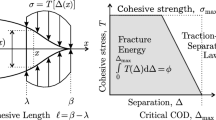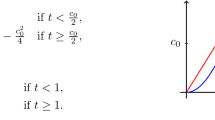Abstract
The paper presents a computational approach and numerical data which facilitate the use of the smeared-tip method for cohesive fracture in large enough structures. In the recently developed K-version of the smeared tip method, the large-size asymptotic profile of the stress intensity factor density along a cohesive crack is considered as a material characteristic, which is uniquely related to the softening stress-displacement law of the cohesive crack. After reviewing the K-version, an accurate and efficient numerical algorithm for the computation of this asymptotic profile is presented. The algorithm is based on solving a singular Abel’s integral equation. The profiles corresponding to various typical softening stress-displacement laws of the cohesive crack model are computed, tabulated and plotted. The profiles for a certain range of other typical softening laws can be approximately obtained by interpolation from the tables. Knowing the profile, one can obtain with the smeared-tip method an analytical expression for the large-size solution to fracture problems, including the first two asymptotic terms of the size effect law. Consequently, numerical solutions of the integral equations of the cohesive crack model as well as finite element simulations of the cohesive crack are made superfluous. However, when the fracture process zone is attached to a notch or to the body surface and the cohesive zone ends with a stress jump, the solution is expected to be accurate only for large-enough structures.
Similar content being viewed by others
References
Barenblatt, G. I. (1959). The formation of equilibrium cracks during brittle fracture, general ideas and hypothesis, axially symmetric cracks.Prikladnaya Matematika i Mekhanika 23(3), 434–444.
Barenblatt, G. I. (1962). The mathematical theory of equilibrium of cracks in brittle fracture.Advances in Applied Mechanics 7, 55–129.
Bažant, Z. P. (1983). Fracture in concrete and reinforced concrete. Preprints, IUTAM Prager Symposium onMechanics of Geomaterials: Rocks, Concretes, Soil, (edited by Z. P. Bažant, Northwestern University, Evanston, 281–316.
Bažant, Z. P. (1984). Size effect in blunt fracture: Concrete, rock, metal.Journal of Engineering Mechanics, ASCE 110, 518–535.
Bažant, Z. P. (1990). Smeared-tip superposition method for nonlinear and time-dependent fracture.Mechanics Research Communications 17(5), 343–351.
Bažant, Z. P. (2001). Size effects in quasibrittle fracture: Apercu of recent results.Fracture Mechanics of Concrete Structures (Proc., FraMCoS-4 Int. Conf., Paris), R. de Borst, J. Mazars, G. Pijaudier-Cabot and J.G.M. van Mier (eds.), Swets & Zeitlinger (A.A. Balkema Publishers), Lisse, 651–658.
Bažant, Z. P. (2002).Scaling of Structural Strength, Hermes-Penton Science, London.
Bažant, Z. P. and Becq-Giraudon, E. (2001). Statistical prediction of fracture parameters of concrete and comparison of testing methods.Cement and Concrete Research 32(4), 529–556.
Bažant, Z. P. and Beissel, S. (1994). Smeared-tip superposition method for cohesive fracture with rate effect and creep.International Journal of Fracture 65, 277–290.
Bažant, Z. P. and Li, Y.-N. (1995). Stability of cohesive crack model: Part II—Eigenvalue analysis of size effect on strength and ductility of structures. Trans. ASME,Journal of Applied Mechanics 62, 965–969.
Bažant, Z. P. and Planas, J. (1998).Fracture and Size Effect in Concrete and Other Quasibrittle Materials, CRC Press, New York.
Guinea, G. V., Planas, J. and Elices, M. (1994). Correlation between the softening and the size effect curves.Size Effect in Concrete Structures, H. Mihashi, H. Okamura and Z. P. Bažant, eds., E&FN Spon, London, 233–244.
Hillerborg, A., Modéer, M. and Petersson, P.E. (1976). Analysis of crack formation and crack growth in concrete by means of fracture mechanics and finite elements.Cement and Concrete Research 6, 773–782.
Kfouri, A. P. and Rice, J.R. (1977). Elastic-plastic separation energy rate for crack advance in finite growth steps,Fracture 1977, (Proc. 4th Int. Conf. on Fracture, ICF4, Waterloo), D. M. R. Taplin, ed., Univ. of Waterloo, Ontario, Canada, Vol. 1, 43–59.
Knauss, W. G. (1973). The mechanics of polymer fracture,Appled Mechanics Reviews 26, 1–17.
Knauss, W. G. (1974). On the steady propagation of a crack in a viscoelastic sheet: Experiments and analysis,Mechanics of Fracture, F. Erdogan, ed., ASME, New York, (AMD-19), 69–103.
Murakami, Y. (1986).Stress intensity factors handbook, 1st edition, Pergamon, Oxford.
Needleman, A. (1990). An analysis of tensile decohesion along an interface.Journal of the Mechanics and Physics of Solids 38(3), 289–324.
Palmer, A. C. and Rice, J.R. (1973). The growth of slip surfaces on the progressive failure of over-consolidated clay.Proceedings of The Royal Society of London, Series A. 332, 527–548.
Petersson, P. E. (1981).Crack growth and development of fracture zone in plain concrete and similar materials, Report No. TVBM-1006, Division of Building Materials, Lund Institute of Technology, Lund, Sweden.
Planas, J. (1986). Un nuevo método de análisis del comportamiento de una fisura cohesiva en Modo I.Anales de Mecánica de la Fractura 3, 219–227.
Planas, J. and Elices, M. (1992). Asymptotic analysis of a cohesive crack: 1. Theoretical background.International Journal of Fracture 55, 153–177.
Planas, J. and Elices, M. (1993). Asymptotic analysis of a cohesive crack: 2. Influence of the softening curve.International Journal of Fracture 64, 221–237.
Planas, J., Elices, M. and Guinea, G.V. (1992). Measurement of the fracture energy using three-point bend tests: Part 2—Influence of bulk energy dissipation.Materials and Structures 25, 305–312.
Planas, J., Elices, M. and Guinea, G.V. (1994). Cohesive cracks as a solution of a class of nonlocal models, inFracture and Damage of Quasibrittle Structures, Z. P. Bažant, Z. Bittnar, M. Jirásek and J. Mazars, eds., E & FN Spon, London, 131–144.
Rice, J. R. (1968). Path independent integral and approximate analysis of strain concentrations by notches and cracks.Journal of Applied Mechanics, ASME 35, 379–386.
Smith, E. (1995). Recent research on the cohesive zone description of an elastic softening material, inFracture of Brittle Disordered Materials: Concrete, Rock, Ceramics, G. Baker and B. L. Karihaloo, eds., E & FN Spon, London, 450–463.
Smith, E. (1999). The effect of the stress-relative displacement law on failure prediction using the cohesive crack model.International Journal of Fracture 91, 41–51.
Tada, H., Paris, P.C. and Irwin, G.R. (1985).The stress analysis of cracks handbook, Del Research Corp., Hellertown, PA..
Wittmann, F. H., Rokugo, K., Brühwiler, E., Mihashi, H. and Simonin, P. (1988). Fracture energy and strain softening of concrete as determined by means of compact tension specimens.Materials and Structures 21, 21–32.
Zi, G. and Bažant, Z.P. (2002). Eigenvalue method for computing size effect of cohesive crack with residual stress, with application to kink bands in composites.International Journal of Engineering Science, in press.
Author information
Authors and Affiliations
Rights and permissions
About this article
Cite this article
Bažant, Z.P., Zi, G. Asymptotic stress intensity factor density profiles for smeared-tip method for cohesive fracture. Int J Fract 119, 145–159 (2003). https://doi.org/10.1023/A:1023947027391
Received:
Accepted:
Issue Date:
DOI: https://doi.org/10.1023/A:1023947027391




